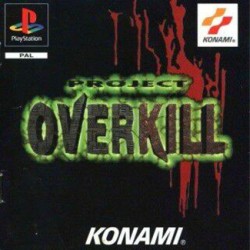Software:Project Overkill
| Project Overkill | |
|---|---|
 | |
| Developer(s) | Konami Chicago |
| Publisher(s) | Konami |
| Platform(s) | PlayStation |
| Release | |
| Genre(s) | Shoot 'em up |
| Mode(s) | Single-player |
Project Overkill is a shoot 'em up game for the PlayStation, developed and published by Konami in 1996. The plot of the game revolves around a group of four mercenaries hired to eliminate a group of humans called the Viscerians.
Gameplay
The gameplay takes on a 3D-esque isometric view, in which the player chooses one of four mercenaries to lead through the levels. The characters act as lives, and if one were killed, the player still has the choice among the remaining mercenaries (rather than having multiple lives for one character).[1] In the levels, the player must find key-cards, destroy guards, aliens, and robots, activate laser bridges, to complete an objective. Objectives include finding the exit to the level, assassination of an officer, escorting a defect or other important official, retrieving an item (usually a memory chip or the like), or obtaining a certain percentage of kills in the area.
The four characters have very different abilities.[1] For example, the large alien, Quogg, has a melee attack that will kill the standard human troops in just one hit (rather than the two required from the other characters). Also, each character has slight variations in weaponry that make for somewhat different combat experiences.
Development
During development the game's producer and designer, who spoke on condition of anonymity, commented, "We chose the isometric perspective because it meant you could see more of the playing area and also you could see an arrow go through the chest and you can see the result from behind too."[1]
The soundtrack was written by Mark Yoshimoto Nemcoff.[2]
Work on a port for the Sega Saturn began while the PlayStation version was still in development.[1] However, it was never released.
Reception
| Reception | ||||||||||||||||||||
|---|---|---|---|---|---|---|---|---|---|---|---|---|---|---|---|---|---|---|---|---|
| ||||||||||||||||||||
Reviewers widely condemned the game's control system, in that the player aims their weapon using the four action buttons, saying it makes lining up shots frustratingly difficult and often leads to running out of ammunition.[4][7][9][11][13] However, overall assessments of the game varied widely. GameSpot's Jeff Kitts and an IGN reviewer both panned the game as a Loaded clone which lacks the enticing music, impressive graphical effects, and excitement which made that game popular, retaining only the mindless ultra-violent gameplay which had since been done to death.[7][9] A Next Generation reviewer and Dan Hsu of Electronic Gaming Monthly both acknowledged that Project Overkill is just the latest in a growing pile of mindless ultra-violent shooters, but contended that it is one of the better games of its breed and is enjoyable when taken for what it is.[4][11] In contrast, Hsu's co-reviewers Shawn Smith and Sushi-X asserted that unlike other violent shooters, Project Overkill is deep and challenging.[4] GamePro took a middle ground position, calling it "flawed but engaging".[13]
Notes
References
- ↑ 1.0 1.1 1.2 1.3 Hickman, Sam (July 1996). "That Gotta Hurt!". Sega Saturn Magazine (Emap International Limited) (9): 42–45.
- ↑ [1][yes|permanent dead link|dead link}}]
- ↑ Sackenheim, Shawn. "Project Overkill – Review". Archived from the original on November 16, 2014. https://web.archive.org/web/20141116134910/http://www.allgame.com/game.php?id=2244&tab=review. Retrieved June 2, 2021.
- ↑ 4.0 4.1 4.2 4.3 "Review Crew: Project Overkill". Electronic Gaming Monthly (Ziff Davis) (87): 62. October 1996.
- ↑ Reiner; Andy; Jon. "Project Overkill". Game Informer (42): 35. https://archive.org/download/game-informer-us-042/GameInformer_US_042.pdf. Retrieved June 2, 2021.
- ↑ "Viewpoint". GameFan 4 (11): 12, 14, 16, 18. December 1996. https://archive.org/details/Gamefan_Vol_4_Issue_11/page/n13/mode/2up. Retrieved June 2, 2021.
- ↑ 7.0 7.1 7.2 Kitts, Jeff (December 1, 1996). "Project Overkill Review". GameSpot. https://www.gamespot.com/reviews/project-overkill-review/1900-2548966/. Retrieved 2017-11-03.
- ↑ Maragos, Harry (February 1997). "Project Overkill". Hyper (40): 34–35. https://archive.org/details/hyper-040/page/34/mode/2up. Retrieved June 2, 2021.
- ↑ 9.0 9.1 9.2 "Project Overkill". January 21, 1997. http://www.ign.com/articles/1997/01/21/project-overkill. Retrieved 3 November 2017.
- ↑ Steve; Matt (November 1996). "Project Overkill". Mean Machines Playstation (2): 40–41. https://archive.org/details/meanmachinesplaystation2/page/n39/mode/2up. Retrieved June 2, 2021.
- ↑ 11.0 11.1 11.2 "Project Overkill". Next Generation (Imagine Media) (23): 268, 271. November 1996.
- ↑ "Game of the Month: Project Overkill". Video Games: The Ultimate Gaming Magazine (90): 66–67. July 1996. https://archive.org/details/video-games-the-ultimate-gaming-magazine-issue-90-july-1996/page/n65/mode/2up?q=%22Project+Overkill+%22. Retrieved June 2, 2021.
- ↑ 13.0 13.1 Air Hendrix (October 1996). "ProReview: Project Overkill". GamePro (IDG) (98): 110.
External links
 |

